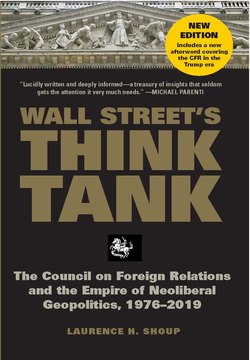Читать книгу Wall Street's Think Tank - Laurence H. Shoup - Страница 12
На сайте Литреса книга снята с продажи.
Оглавление3
THE CFR’S DOMESTIC NETWORK, 1976–2014
A meeting ground for powerful members of the U.S. corporate and foreign policy establishments….
—DAVID C. KORTEN
The Council counts among its members probably more important names in American life than any other private group in the country
—THEODORE WHITE
The Council on Foreign Relations is the ultimate networking and socializing institution of the U.S. capitalist ruling class. But it does not operate in isolation; rather, it is at the center of an extensive network of key institutions in a number of interconnected realms of U.S. social life: politics, think tanks, finance and economics, higher education, philanthropy, media, and culture. The U.S. capitalist class has a core and a periphery. The CFR and its members are at the core of the dominant sector of this class, but the network extends broadly. The nearly 5,000 individuals who are members and leaders of the Council collectively have hundreds of thousands of ties—social, economic, and political relationships that bind them into a community of the powerful. This is one reason why so many people want to join and participate in the Council and its activities. Those at the core of the large clique that makes up the CFR’s inner circle have common traits, access to the same general information, and mostly homogeneous opinions. They have close and frequent interactions—a daisy chain of connections to various organizations—resulting in strong ties and relationships with one another and powerful positions in their own groups, the political economy, and the larger society. Those with less close links may reflect the phenomena of the “strength of weak ties.” This phenomena points out the reality that to make new connections, gain new insights, and acquire new information, members of the core clique must look beyond it to others less closely attached. Such weak ties then become stronger. The end result is a verification of the folk wisdom in the statement that advancing in life is often based on “not what you know but who you know.”
The approach in this chapter will be to compare lists of the key individuals, the decision makers, of what are widely considered to be central organizations in a given profit or nonprofit field, with the 2011 to 2014 CFR membership lists and the historical list of all Council directors. This procedure will document the vast number of interlocks between the CFR and most of the key institutions of U.S. society and political economy. Interlocks represent sociological anchors of a community of interest; they develop and cement the personal and institutional relationships that create the common ideology, cohesion, coordinated action, and unified political-economic influence and power of the capitalist class and its allies. At the same time, intra-ruling class conflict is reduced. Showing how the Council is at the center of a vast domestic network of the powerful, including a majority of the most important think tanks, represents additional concrete evidence that it is the most powerful organization in the United States and the world. Other think tanks around the globe have been established and grown up “under the shadow of American intellectual hegemony.”266 One recent work on think tanks elaborates as follows on this theme:
The United States remains … the superpower of policy research: the prime exporter of concepts and intellectual frameworks, the most important source of transnational funding, the model that others take as their point of reference in the post–Cold War world. It is this intellectual “soft power” that leaves the USA “bound to lead” global political and economic order…. Across Europe, for example, students of foreign policy read the CFR journal Foreign Affairs, and take the arguments they find there as a starting point for their own work…. No European policy review attracts similar attention.267
